Financial Reporting Analysis: Objectives, Framework, and Value
VerifiedAdded on 2021/02/21
|8
|1972
|66
Report
AI Summary
This report provides a comprehensive analysis of financial reporting. It begins by defining financial reporting and outlining its purpose, which includes providing information for decision-making and presenting an organization's financial position. The report then delves into the conceptual and regulatory framework, explaining its meaning, purpose, and key principles like relevance and faithful representation. The report identifies and discusses the main stakeholders of an organization, such as management, shareholders, investors, and creditors, and explains how they benefit from financial information. Finally, the report explores the value of financial reporting in meeting organizational objectives and fostering growth, highlighting its role in profit maximization, wealth maximization, and informed decision-making. The report emphasizes the importance of financial reports in identifying areas for improvement and guiding investment decisions to achieve set targets and organizational success. The report concludes by emphasizing the importance of financial reporting for organizational growth and objectives.

Financial Reporting
Paraphrase This Document
Need a fresh take? Get an instant paraphrase of this document with our AI Paraphraser
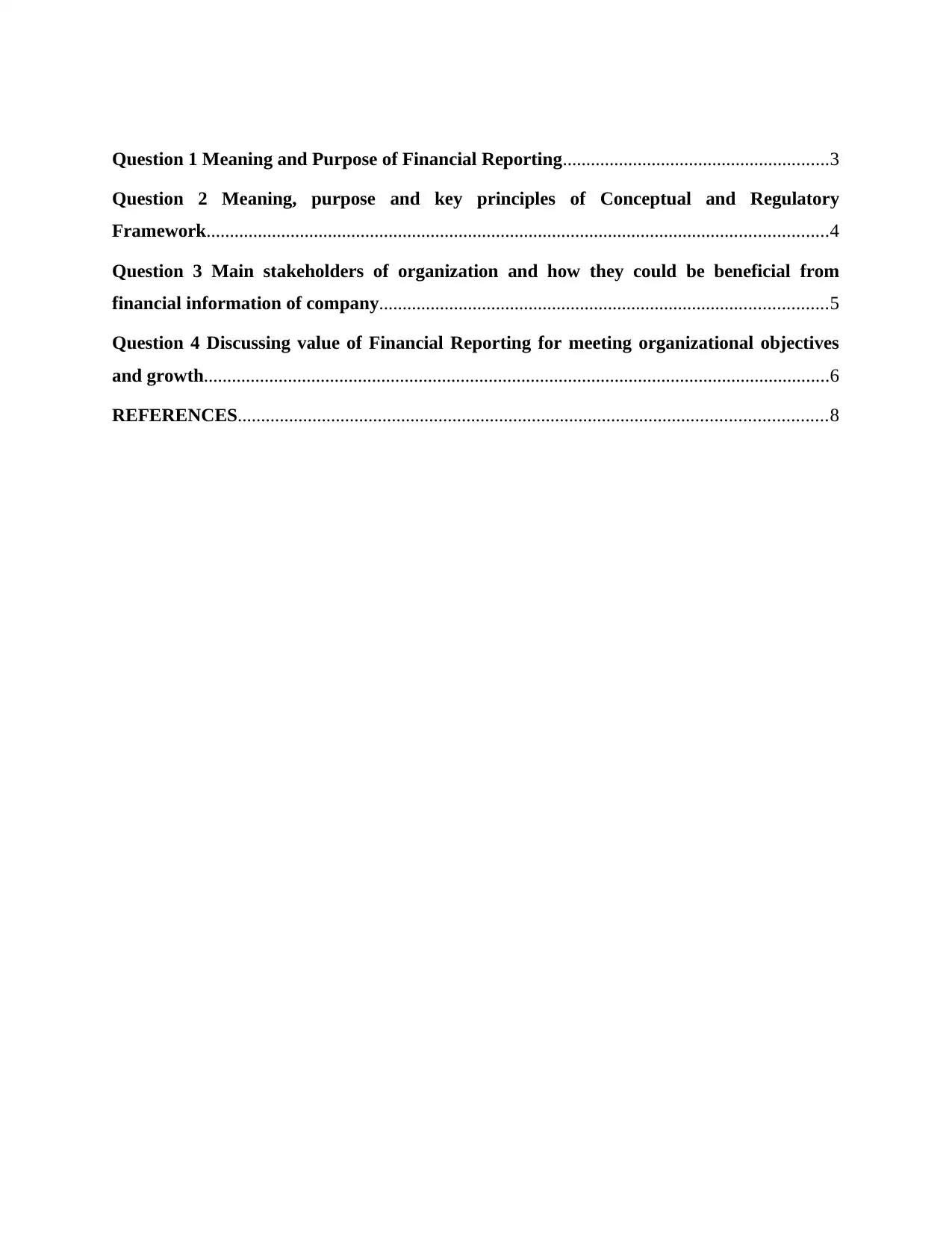
Question 1 Meaning and Purpose of Financial Reporting.........................................................3
Question 2 Meaning, purpose and key principles of Conceptual and Regulatory
Framework.....................................................................................................................................4
Question 3 Main stakeholders of organization and how they could be beneficial from
financial information of company................................................................................................5
Question 4 Discussing value of Financial Reporting for meeting organizational objectives
and growth......................................................................................................................................6
REFERENCES..............................................................................................................................8
Question 2 Meaning, purpose and key principles of Conceptual and Regulatory
Framework.....................................................................................................................................4
Question 3 Main stakeholders of organization and how they could be beneficial from
financial information of company................................................................................................5
Question 4 Discussing value of Financial Reporting for meeting organizational objectives
and growth......................................................................................................................................6
REFERENCES..............................................................................................................................8
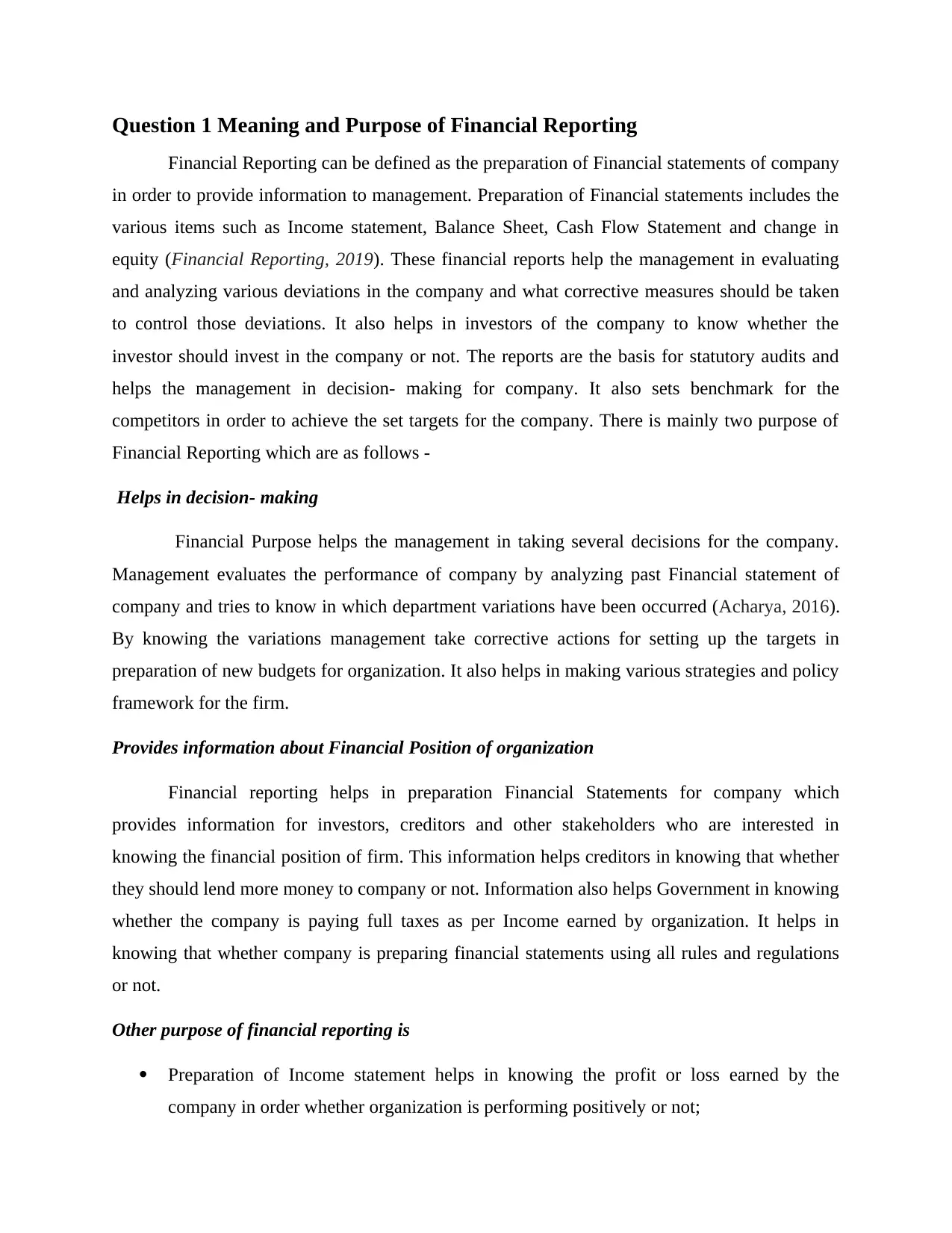
Question 1 Meaning and Purpose of Financial Reporting
Financial Reporting can be defined as the preparation of Financial statements of company
in order to provide information to management. Preparation of Financial statements includes the
various items such as Income statement, Balance Sheet, Cash Flow Statement and change in
equity (Financial Reporting, 2019). These financial reports help the management in evaluating
and analyzing various deviations in the company and what corrective measures should be taken
to control those deviations. It also helps in investors of the company to know whether the
investor should invest in the company or not. The reports are the basis for statutory audits and
helps the management in decision- making for company. It also sets benchmark for the
competitors in order to achieve the set targets for the company. There is mainly two purpose of
Financial Reporting which are as follows -
Helps in decision- making
Financial Purpose helps the management in taking several decisions for the company.
Management evaluates the performance of company by analyzing past Financial statement of
company and tries to know in which department variations have been occurred (Acharya, 2016).
By knowing the variations management take corrective actions for setting up the targets in
preparation of new budgets for organization. It also helps in making various strategies and policy
framework for the firm.
Provides information about Financial Position of organization
Financial reporting helps in preparation Financial Statements for company which
provides information for investors, creditors and other stakeholders who are interested in
knowing the financial position of firm. This information helps creditors in knowing that whether
they should lend more money to company or not. Information also helps Government in knowing
whether the company is paying full taxes as per Income earned by organization. It helps in
knowing that whether company is preparing financial statements using all rules and regulations
or not.
Other purpose of financial reporting is
Preparation of Income statement helps in knowing the profit or loss earned by the
company in order whether organization is performing positively or not;
Financial Reporting can be defined as the preparation of Financial statements of company
in order to provide information to management. Preparation of Financial statements includes the
various items such as Income statement, Balance Sheet, Cash Flow Statement and change in
equity (Financial Reporting, 2019). These financial reports help the management in evaluating
and analyzing various deviations in the company and what corrective measures should be taken
to control those deviations. It also helps in investors of the company to know whether the
investor should invest in the company or not. The reports are the basis for statutory audits and
helps the management in decision- making for company. It also sets benchmark for the
competitors in order to achieve the set targets for the company. There is mainly two purpose of
Financial Reporting which are as follows -
Helps in decision- making
Financial Purpose helps the management in taking several decisions for the company.
Management evaluates the performance of company by analyzing past Financial statement of
company and tries to know in which department variations have been occurred (Acharya, 2016).
By knowing the variations management take corrective actions for setting up the targets in
preparation of new budgets for organization. It also helps in making various strategies and policy
framework for the firm.
Provides information about Financial Position of organization
Financial reporting helps in preparation Financial Statements for company which
provides information for investors, creditors and other stakeholders who are interested in
knowing the financial position of firm. This information helps creditors in knowing that whether
they should lend more money to company or not. Information also helps Government in knowing
whether the company is paying full taxes as per Income earned by organization. It helps in
knowing that whether company is preparing financial statements using all rules and regulations
or not.
Other purpose of financial reporting is
Preparation of Income statement helps in knowing the profit or loss earned by the
company in order whether organization is performing positively or not;
⊘ This is a preview!⊘
Do you want full access?
Subscribe today to unlock all pages.

Trusted by 1+ million students worldwide
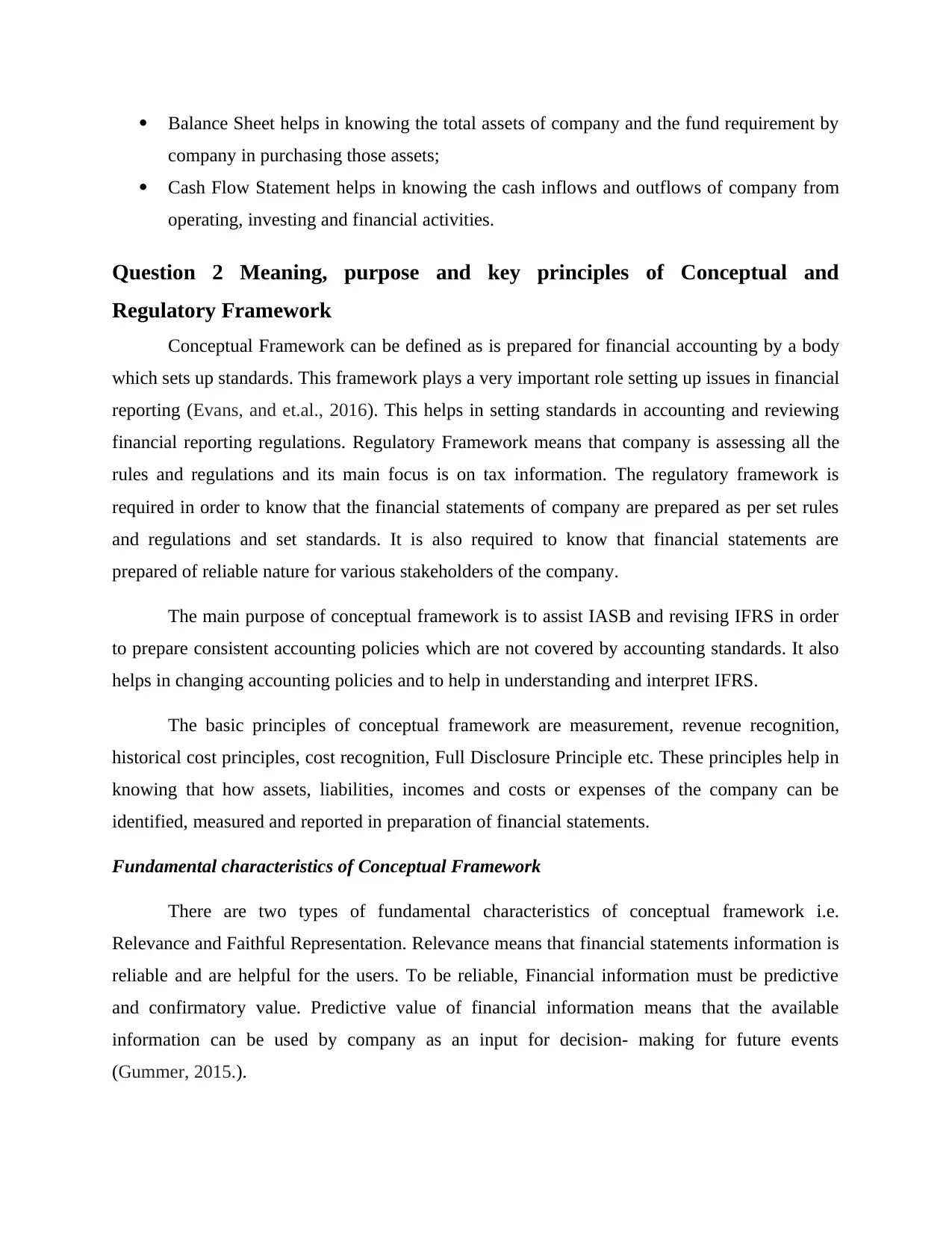
Balance Sheet helps in knowing the total assets of company and the fund requirement by
company in purchasing those assets;
Cash Flow Statement helps in knowing the cash inflows and outflows of company from
operating, investing and financial activities.
Question 2 Meaning, purpose and key principles of Conceptual and
Regulatory Framework
Conceptual Framework can be defined as is prepared for financial accounting by a body
which sets up standards. This framework plays a very important role setting up issues in financial
reporting (Evans, and et.al., 2016). This helps in setting standards in accounting and reviewing
financial reporting regulations. Regulatory Framework means that company is assessing all the
rules and regulations and its main focus is on tax information. The regulatory framework is
required in order to know that the financial statements of company are prepared as per set rules
and regulations and set standards. It is also required to know that financial statements are
prepared of reliable nature for various stakeholders of the company.
The main purpose of conceptual framework is to assist IASB and revising IFRS in order
to prepare consistent accounting policies which are not covered by accounting standards. It also
helps in changing accounting policies and to help in understanding and interpret IFRS.
The basic principles of conceptual framework are measurement, revenue recognition,
historical cost principles, cost recognition, Full Disclosure Principle etc. These principles help in
knowing that how assets, liabilities, incomes and costs or expenses of the company can be
identified, measured and reported in preparation of financial statements.
Fundamental characteristics of Conceptual Framework
There are two types of fundamental characteristics of conceptual framework i.e.
Relevance and Faithful Representation. Relevance means that financial statements information is
reliable and are helpful for the users. To be reliable, Financial information must be predictive
and confirmatory value. Predictive value of financial information means that the available
information can be used by company as an input for decision- making for future events
(Gummer, 2015.).
company in purchasing those assets;
Cash Flow Statement helps in knowing the cash inflows and outflows of company from
operating, investing and financial activities.
Question 2 Meaning, purpose and key principles of Conceptual and
Regulatory Framework
Conceptual Framework can be defined as is prepared for financial accounting by a body
which sets up standards. This framework plays a very important role setting up issues in financial
reporting (Evans, and et.al., 2016). This helps in setting standards in accounting and reviewing
financial reporting regulations. Regulatory Framework means that company is assessing all the
rules and regulations and its main focus is on tax information. The regulatory framework is
required in order to know that the financial statements of company are prepared as per set rules
and regulations and set standards. It is also required to know that financial statements are
prepared of reliable nature for various stakeholders of the company.
The main purpose of conceptual framework is to assist IASB and revising IFRS in order
to prepare consistent accounting policies which are not covered by accounting standards. It also
helps in changing accounting policies and to help in understanding and interpret IFRS.
The basic principles of conceptual framework are measurement, revenue recognition,
historical cost principles, cost recognition, Full Disclosure Principle etc. These principles help in
knowing that how assets, liabilities, incomes and costs or expenses of the company can be
identified, measured and reported in preparation of financial statements.
Fundamental characteristics of Conceptual Framework
There are two types of fundamental characteristics of conceptual framework i.e.
Relevance and Faithful Representation. Relevance means that financial statements information is
reliable and are helpful for the users. To be reliable, Financial information must be predictive
and confirmatory value. Predictive value of financial information means that the available
information can be used by company as an input for decision- making for future events
(Gummer, 2015.).
Paraphrase This Document
Need a fresh take? Get an instant paraphrase of this document with our AI Paraphraser
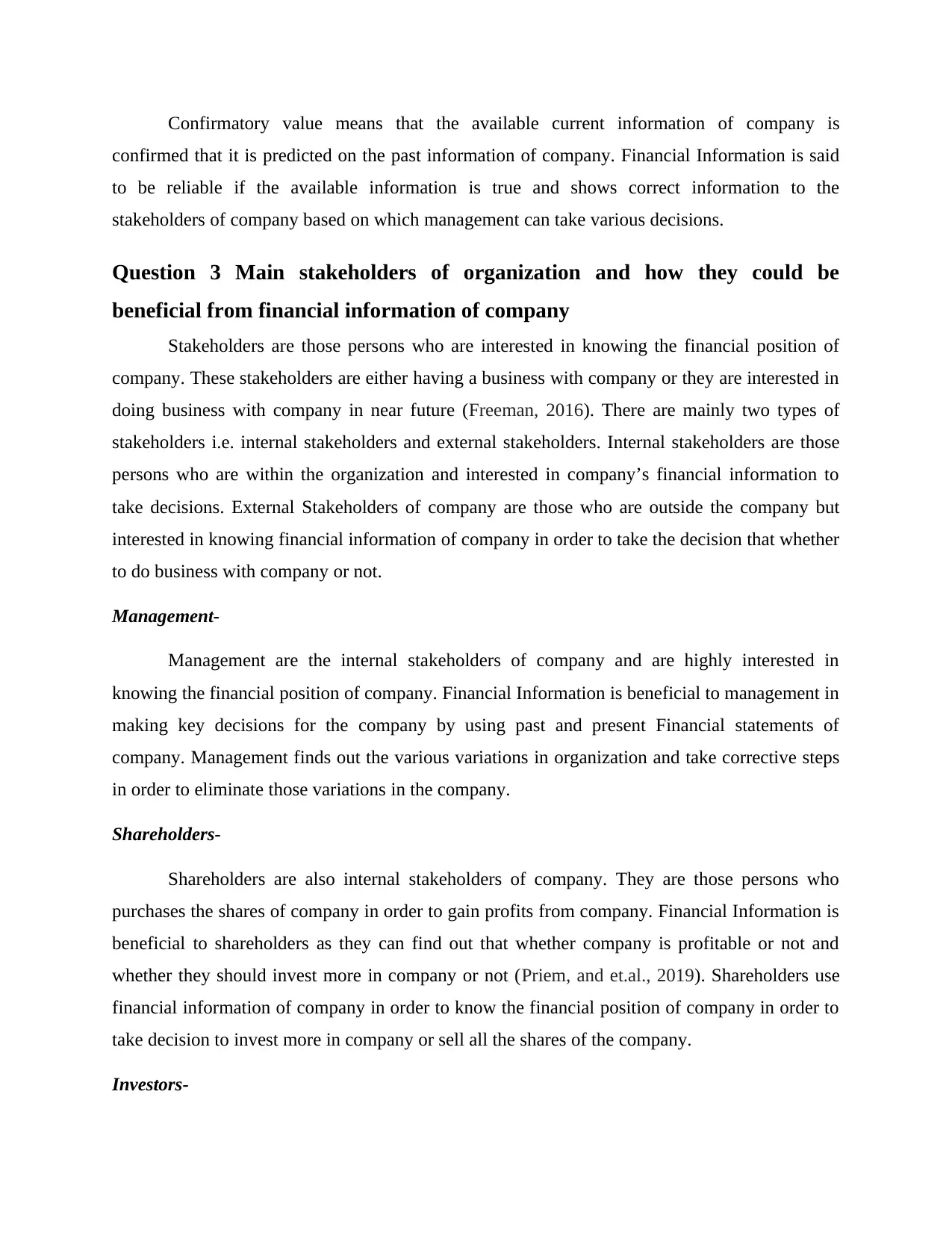
Confirmatory value means that the available current information of company is
confirmed that it is predicted on the past information of company. Financial Information is said
to be reliable if the available information is true and shows correct information to the
stakeholders of company based on which management can take various decisions.
Question 3 Main stakeholders of organization and how they could be
beneficial from financial information of company
Stakeholders are those persons who are interested in knowing the financial position of
company. These stakeholders are either having a business with company or they are interested in
doing business with company in near future (Freeman, 2016). There are mainly two types of
stakeholders i.e. internal stakeholders and external stakeholders. Internal stakeholders are those
persons who are within the organization and interested in company’s financial information to
take decisions. External Stakeholders of company are those who are outside the company but
interested in knowing financial information of company in order to take the decision that whether
to do business with company or not.
Management-
Management are the internal stakeholders of company and are highly interested in
knowing the financial position of company. Financial Information is beneficial to management in
making key decisions for the company by using past and present Financial statements of
company. Management finds out the various variations in organization and take corrective steps
in order to eliminate those variations in the company.
Shareholders-
Shareholders are also internal stakeholders of company. They are those persons who
purchases the shares of company in order to gain profits from company. Financial Information is
beneficial to shareholders as they can find out that whether company is profitable or not and
whether they should invest more in company or not (Priem, and et.al., 2019). Shareholders use
financial information of company in order to know the financial position of company in order to
take decision to invest more in company or sell all the shares of the company.
Investors-
confirmed that it is predicted on the past information of company. Financial Information is said
to be reliable if the available information is true and shows correct information to the
stakeholders of company based on which management can take various decisions.
Question 3 Main stakeholders of organization and how they could be
beneficial from financial information of company
Stakeholders are those persons who are interested in knowing the financial position of
company. These stakeholders are either having a business with company or they are interested in
doing business with company in near future (Freeman, 2016). There are mainly two types of
stakeholders i.e. internal stakeholders and external stakeholders. Internal stakeholders are those
persons who are within the organization and interested in company’s financial information to
take decisions. External Stakeholders of company are those who are outside the company but
interested in knowing financial information of company in order to take the decision that whether
to do business with company or not.
Management-
Management are the internal stakeholders of company and are highly interested in
knowing the financial position of company. Financial Information is beneficial to management in
making key decisions for the company by using past and present Financial statements of
company. Management finds out the various variations in organization and take corrective steps
in order to eliminate those variations in the company.
Shareholders-
Shareholders are also internal stakeholders of company. They are those persons who
purchases the shares of company in order to gain profits from company. Financial Information is
beneficial to shareholders as they can find out that whether company is profitable or not and
whether they should invest more in company or not (Priem, and et.al., 2019). Shareholders use
financial information of company in order to know the financial position of company in order to
take decision to invest more in company or sell all the shares of the company.
Investors-
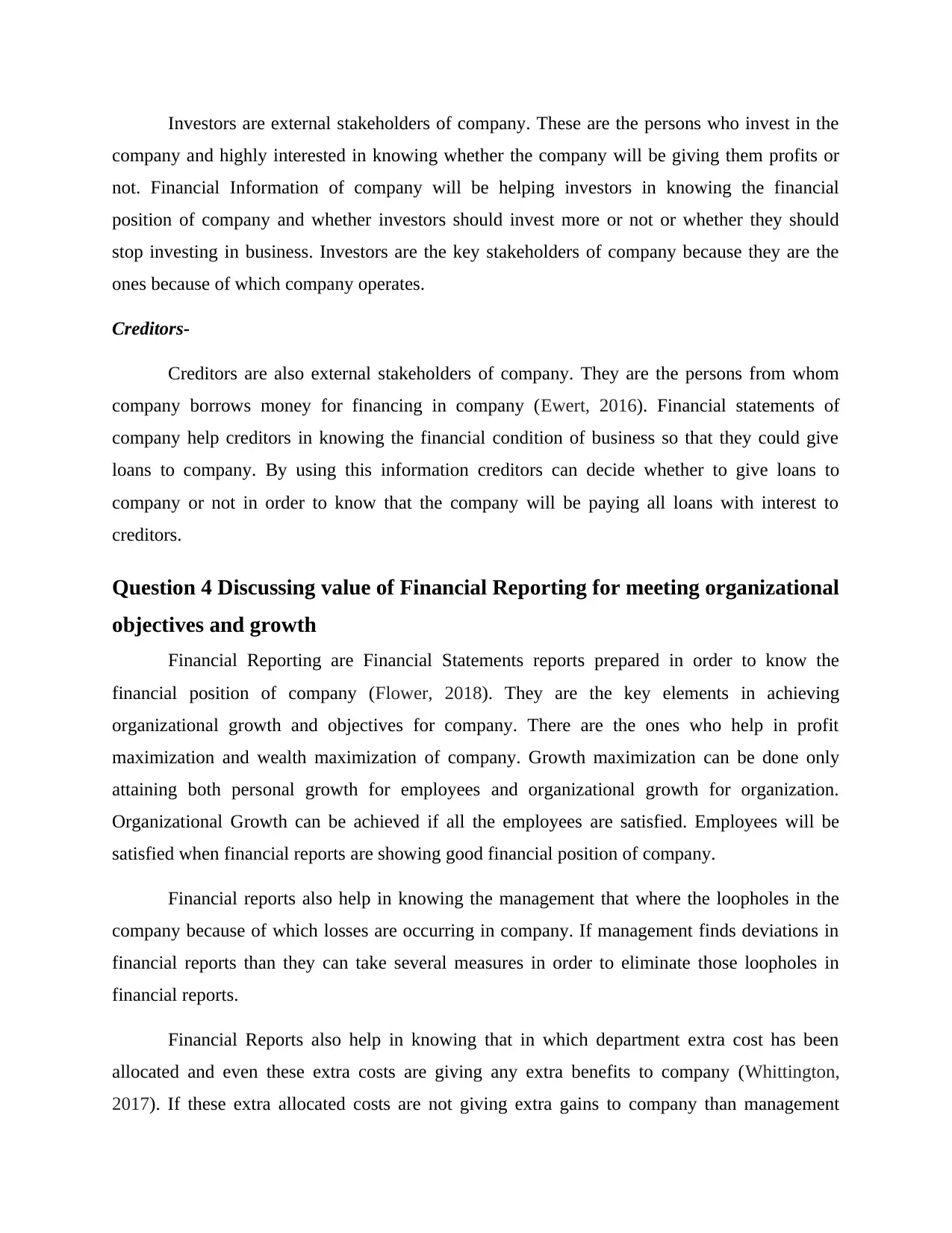
Investors are external stakeholders of company. These are the persons who invest in the
company and highly interested in knowing whether the company will be giving them profits or
not. Financial Information of company will be helping investors in knowing the financial
position of company and whether investors should invest more or not or whether they should
stop investing in business. Investors are the key stakeholders of company because they are the
ones because of which company operates.
Creditors-
Creditors are also external stakeholders of company. They are the persons from whom
company borrows money for financing in company (Ewert, 2016). Financial statements of
company help creditors in knowing the financial condition of business so that they could give
loans to company. By using this information creditors can decide whether to give loans to
company or not in order to know that the company will be paying all loans with interest to
creditors.
Question 4 Discussing value of Financial Reporting for meeting organizational
objectives and growth
Financial Reporting are Financial Statements reports prepared in order to know the
financial position of company (Flower, 2018). They are the key elements in achieving
organizational growth and objectives for company. There are the ones who help in profit
maximization and wealth maximization of company. Growth maximization can be done only
attaining both personal growth for employees and organizational growth for organization.
Organizational Growth can be achieved if all the employees are satisfied. Employees will be
satisfied when financial reports are showing good financial position of company.
Financial reports also help in knowing the management that where the loopholes in the
company because of which losses are occurring in company. If management finds deviations in
financial reports than they can take several measures in order to eliminate those loopholes in
financial reports.
Financial Reports also help in knowing that in which department extra cost has been
allocated and even these extra costs are giving any extra benefits to company (Whittington,
2017). If these extra allocated costs are not giving extra gains to company than management
company and highly interested in knowing whether the company will be giving them profits or
not. Financial Information of company will be helping investors in knowing the financial
position of company and whether investors should invest more or not or whether they should
stop investing in business. Investors are the key stakeholders of company because they are the
ones because of which company operates.
Creditors-
Creditors are also external stakeholders of company. They are the persons from whom
company borrows money for financing in company (Ewert, 2016). Financial statements of
company help creditors in knowing the financial condition of business so that they could give
loans to company. By using this information creditors can decide whether to give loans to
company or not in order to know that the company will be paying all loans with interest to
creditors.
Question 4 Discussing value of Financial Reporting for meeting organizational
objectives and growth
Financial Reporting are Financial Statements reports prepared in order to know the
financial position of company (Flower, 2018). They are the key elements in achieving
organizational growth and objectives for company. There are the ones who help in profit
maximization and wealth maximization of company. Growth maximization can be done only
attaining both personal growth for employees and organizational growth for organization.
Organizational Growth can be achieved if all the employees are satisfied. Employees will be
satisfied when financial reports are showing good financial position of company.
Financial reports also help in knowing the management that where the loopholes in the
company because of which losses are occurring in company. If management finds deviations in
financial reports than they can take several measures in order to eliminate those loopholes in
financial reports.
Financial Reports also help in knowing that in which department extra cost has been
allocated and even these extra costs are giving any extra benefits to company (Whittington,
2017). If these extra allocated costs are not giving extra gains to company than management
⊘ This is a preview!⊘
Do you want full access?
Subscribe today to unlock all pages.

Trusted by 1+ million students worldwide
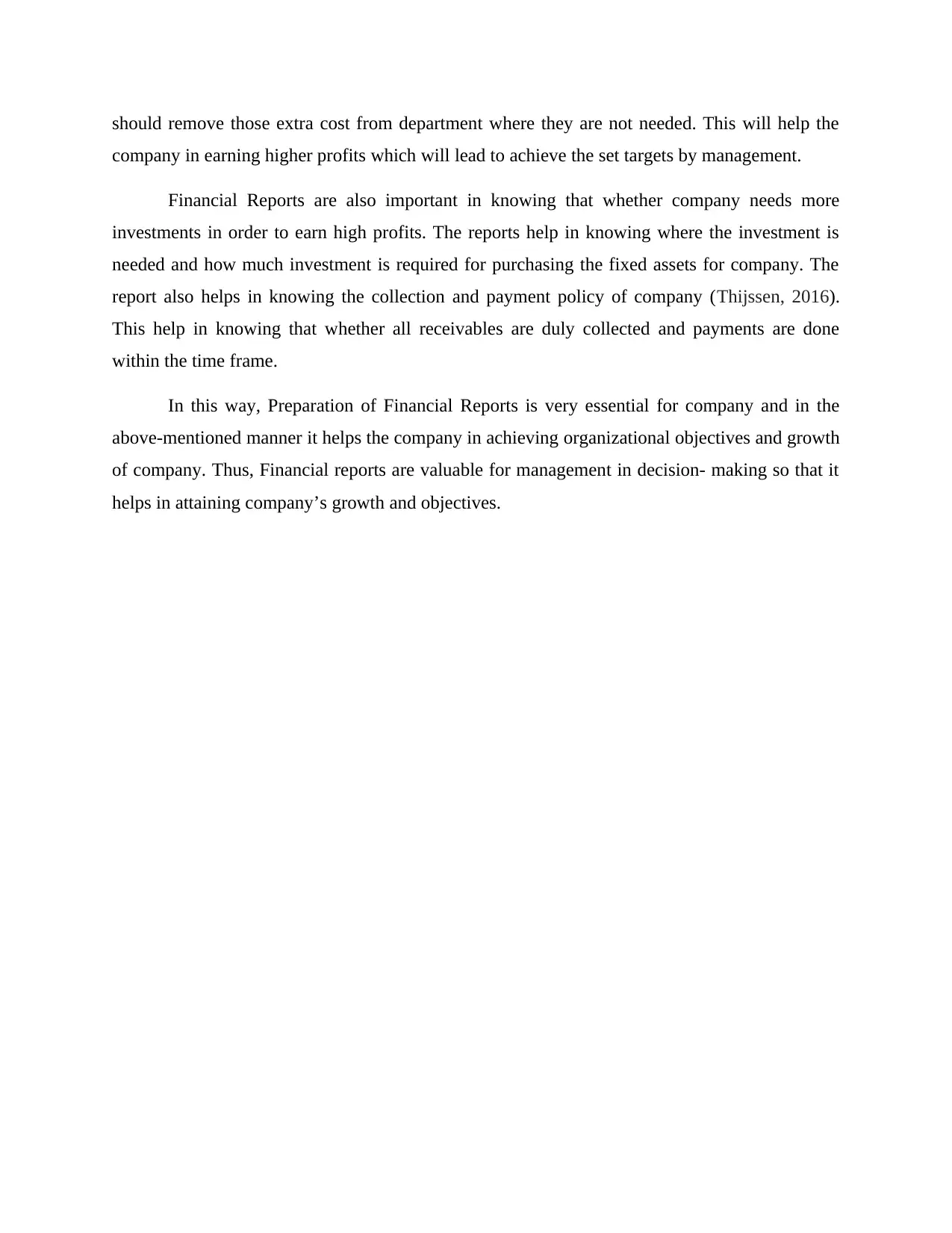
should remove those extra cost from department where they are not needed. This will help the
company in earning higher profits which will lead to achieve the set targets by management.
Financial Reports are also important in knowing that whether company needs more
investments in order to earn high profits. The reports help in knowing where the investment is
needed and how much investment is required for purchasing the fixed assets for company. The
report also helps in knowing the collection and payment policy of company (Thijssen, 2016).
This help in knowing that whether all receivables are duly collected and payments are done
within the time frame.
In this way, Preparation of Financial Reports is very essential for company and in the
above-mentioned manner it helps the company in achieving organizational objectives and growth
of company. Thus, Financial reports are valuable for management in decision- making so that it
helps in attaining company’s growth and objectives.
company in earning higher profits which will lead to achieve the set targets by management.
Financial Reports are also important in knowing that whether company needs more
investments in order to earn high profits. The reports help in knowing where the investment is
needed and how much investment is required for purchasing the fixed assets for company. The
report also helps in knowing the collection and payment policy of company (Thijssen, 2016).
This help in knowing that whether all receivables are duly collected and payments are done
within the time frame.
In this way, Preparation of Financial Reports is very essential for company and in the
above-mentioned manner it helps the company in achieving organizational objectives and growth
of company. Thus, Financial reports are valuable for management in decision- making so that it
helps in attaining company’s growth and objectives.
Paraphrase This Document
Need a fresh take? Get an instant paraphrase of this document with our AI Paraphraser
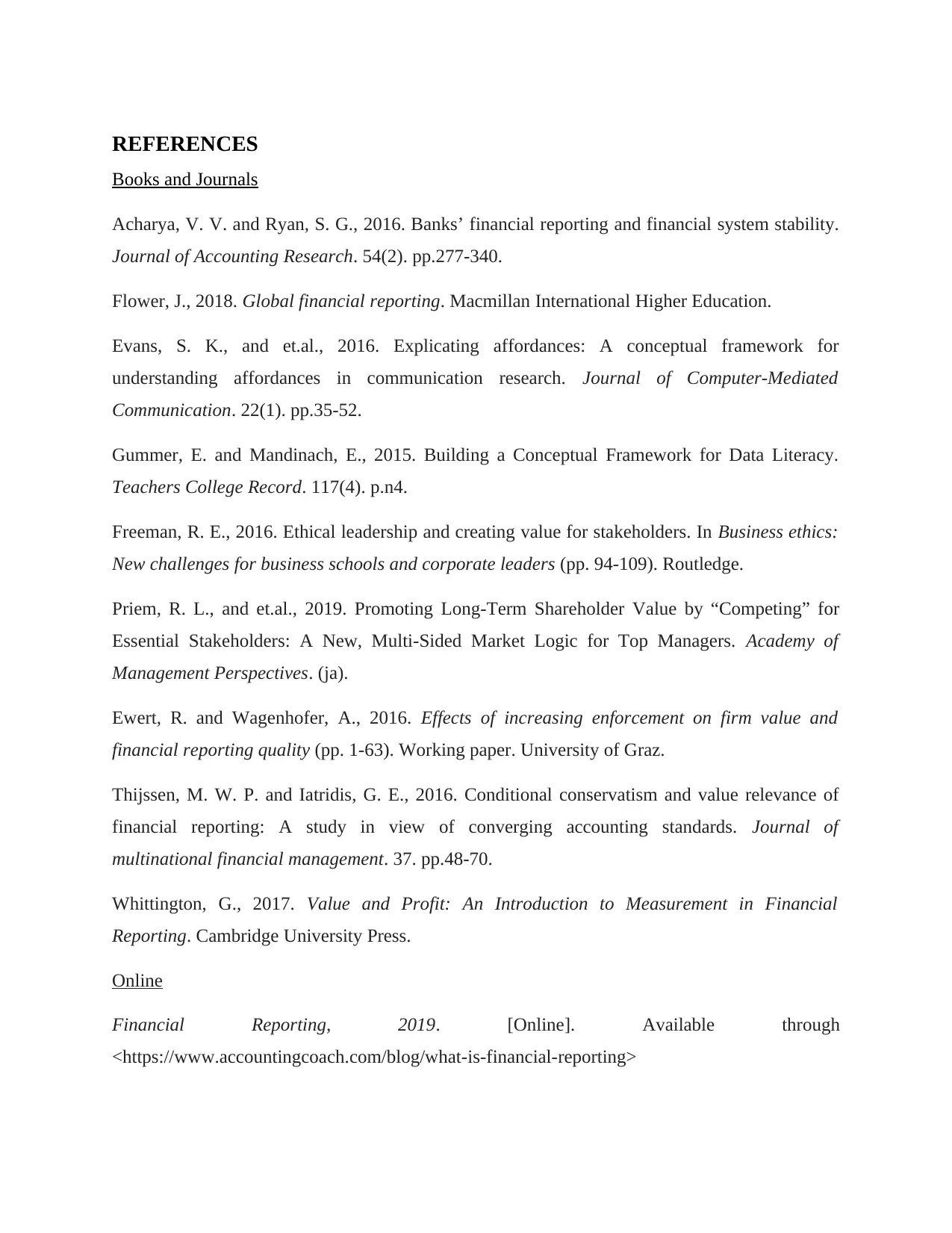
REFERENCES
Books and Journals
Acharya, V. V. and Ryan, S. G., 2016. Banks’ financial reporting and financial system stability.
Journal of Accounting Research. 54(2). pp.277-340.
Flower, J., 2018. Global financial reporting. Macmillan International Higher Education.
Evans, S. K., and et.al., 2016. Explicating affordances: A conceptual framework for
understanding affordances in communication research. Journal of Computer-Mediated
Communication. 22(1). pp.35-52.
Gummer, E. and Mandinach, E., 2015. Building a Conceptual Framework for Data Literacy.
Teachers College Record. 117(4). p.n4.
Freeman, R. E., 2016. Ethical leadership and creating value for stakeholders. In Business ethics:
New challenges for business schools and corporate leaders (pp. 94-109). Routledge.
Priem, R. L., and et.al., 2019. Promoting Long-Term Shareholder Value by “Competing” for
Essential Stakeholders: A New, Multi-Sided Market Logic for Top Managers. Academy of
Management Perspectives. (ja).
Ewert, R. and Wagenhofer, A., 2016. Effects of increasing enforcement on firm value and
financial reporting quality (pp. 1-63). Working paper. University of Graz.
Thijssen, M. W. P. and Iatridis, G. E., 2016. Conditional conservatism and value relevance of
financial reporting: A study in view of converging accounting standards. Journal of
multinational financial management. 37. pp.48-70.
Whittington, G., 2017. Value and Profit: An Introduction to Measurement in Financial
Reporting. Cambridge University Press.
Online
Financial Reporting, 2019. [Online]. Available through
<https://www.accountingcoach.com/blog/what-is-financial-reporting>
Books and Journals
Acharya, V. V. and Ryan, S. G., 2016. Banks’ financial reporting and financial system stability.
Journal of Accounting Research. 54(2). pp.277-340.
Flower, J., 2018. Global financial reporting. Macmillan International Higher Education.
Evans, S. K., and et.al., 2016. Explicating affordances: A conceptual framework for
understanding affordances in communication research. Journal of Computer-Mediated
Communication. 22(1). pp.35-52.
Gummer, E. and Mandinach, E., 2015. Building a Conceptual Framework for Data Literacy.
Teachers College Record. 117(4). p.n4.
Freeman, R. E., 2016. Ethical leadership and creating value for stakeholders. In Business ethics:
New challenges for business schools and corporate leaders (pp. 94-109). Routledge.
Priem, R. L., and et.al., 2019. Promoting Long-Term Shareholder Value by “Competing” for
Essential Stakeholders: A New, Multi-Sided Market Logic for Top Managers. Academy of
Management Perspectives. (ja).
Ewert, R. and Wagenhofer, A., 2016. Effects of increasing enforcement on firm value and
financial reporting quality (pp. 1-63). Working paper. University of Graz.
Thijssen, M. W. P. and Iatridis, G. E., 2016. Conditional conservatism and value relevance of
financial reporting: A study in view of converging accounting standards. Journal of
multinational financial management. 37. pp.48-70.
Whittington, G., 2017. Value and Profit: An Introduction to Measurement in Financial
Reporting. Cambridge University Press.
Online
Financial Reporting, 2019. [Online]. Available through
<https://www.accountingcoach.com/blog/what-is-financial-reporting>
1 out of 8
Related Documents
Your All-in-One AI-Powered Toolkit for Academic Success.
+13062052269
info@desklib.com
Available 24*7 on WhatsApp / Email
![[object Object]](/_next/static/media/star-bottom.7253800d.svg)
Unlock your academic potential
Copyright © 2020–2025 A2Z Services. All Rights Reserved. Developed and managed by ZUCOL.





